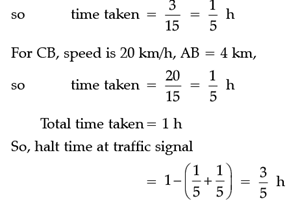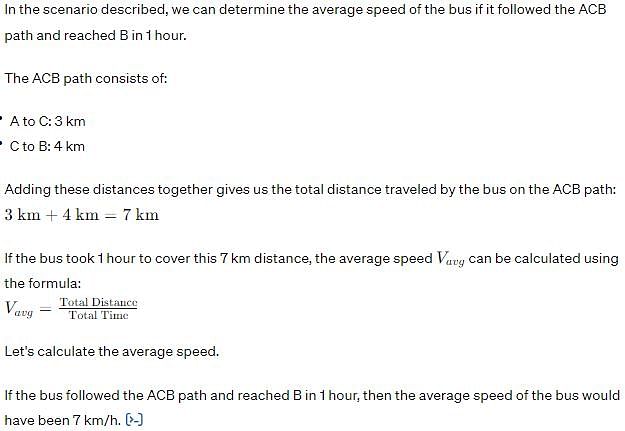Case Based Questions Test: Motion in a Straight Line - NEET MCQ
10 Questions MCQ Test Topic-wise MCQ Tests for NEET - Case Based Questions Test: Motion in a Straight Line
Journey to a picnic spot:
2 friends started for a picnic spot, in two different cars. A drove his car at a constant velocity 60 km/h. B drove his car at a constant velocity 50 km/h. The velocity of B relative to A is VB – VA Similarly, the velocity of object A relative to object B is VA – VB Their friend C was supposed to wait at a point on the road for a lift. Both of them forgot to pick up C. A and B reached the picnic spot within 2 hours and 2 hours 24 minutes respectively.
What was the relative velocity of B relative to A?
Journey to a picnic spot:
2 friends started for a picnic spot, in two different cars. A drove his car at a constant velocity 60 km/h. B drove his car at a constant velocity 50 km/h. The velocity of B relative to A is VB – VA Similarly, the velocity of object A relative to object B is VA – VB Their friend C was supposed to wait at a point on the road for a lift. Both of them forgot to pick up C. A and B reached the picnic spot within 2 hours and 2 hours 24 minutes respectively.
What were the velocities of A and B relative to C?
| 1 Crore+ students have signed up on EduRev. Have you? Download the App |
Journey to a picnic spot:
2 friends started for a picnic spot, in two different cars. A drove his car at a constant velocity 60 km/h. B drove his car at a constant velocity 50 km/h. The velocity of B relative to A is VB – VA Similarly, the velocity of object A relative to object B is VA – VB Their friend C was supposed to wait at a point on the road for a lift. Both of them forgot to pick up C. A and B reached the picnic spot within 2 hours and 2 hours 24 minutes respectively.
How the distance of the picnic spot can be found from the appropriate graph?
A journey:
Tabu lives at A. He was supposed to go to his uncle’s house at B. A and B is connected by a straight road 5 km long. But that day the road was under repair. So, all the buses was following a diversion via C. A to B via C is 7 km. Moreover this route is congested. There is a traffic signal at C also.

Tabu got a seat just behind the driver. He noticed that the minimum reading in the speedometer was 15 km/h. But ultimately the bus took 1 hour to reach B. He could not understand the fallacy.
What is the distance and displacement of Tabu?
A journey:
Tabu lives at A. He was supposed to go to his uncle’s house at B. A and B is connected by a straight road 5 km long. But that day the road was under repair. So, all the buses was following a diversion via C. A to B via C is 7 km. Moreover this route is congested. There is a traffic signal at C also.
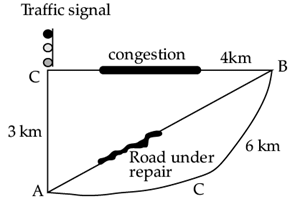
Tabu got a seat just behind the driver. He noticed that the minimum reading in the speedometer was 15 km/h. But ultimately the bus took 1 hour to reach B. He could not understand the fallacy.
Speedometer measures
A journey:
Tabu lives at A. He was supposed to go to his uncle’s house at B. A and B is connected by a straight road 5 km long. But that day the road was under repair. So, all the buses was following a diversion via C. A to B via C is 7 km. Moreover this route is congested. There is a traffic signal at C also.
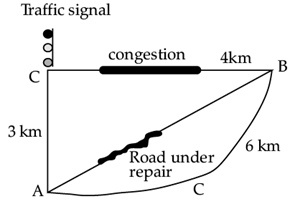
Tabu got a seat just behind the driver. He noticed that the minimum reading in the speedometer was 15 km/h. But ultimately the bus took 1 hour to reach B. He could not understand the fallacy.
Which of the following graphs represents the motion of the bus if it covers AC distance at a speed 15 km/h, CB distance at a speed 20 km/h and total distance is covered in 1 hour including halt at traffic signal.
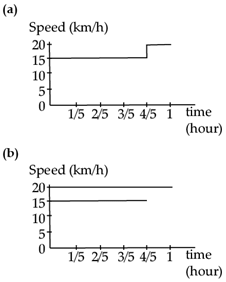
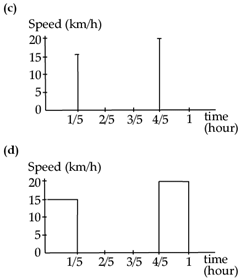
Journey to a picnic spot:
2 friends started for a picnic spot, in two different cars. A drove his car at a constant velocity 60 km/h. B drove his car at a constant velocity 50 km/h. The velocity of B relative to A is VB – VA Similarly, the velocity of object A relative to object B is VA – VB Their friend C was supposed to wait at a point on the road for a lift. Both of them forgot to pick up C. A and B reached the picnic spot within 2 hours and 2 hours 24 minutes respectively.
What was the relative velocity of A relative to B?
Journey to a picnic spot:
2 friends started for a picnic spot, in two different cars. A drove his car at a constant velocity 60 km/h. B drove his car at a constant velocity 50 km/h. The velocity of B relative to A is VB – VA Similarly, the velocity of object A relative to object B is VA – VB Their friend C was supposed to wait at a point on the road for a lift. Both of them forgot to pick up C. A and B reached the picnic spot within 2 hours and 2 hours 24 minutes respectively.
Which one of the following shows the Velocity vs. Time Plot for A?
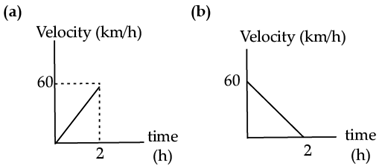
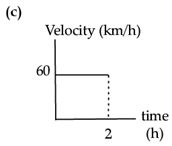
A journey:
Tabu lives at A. He was supposed to go to his uncle’s house at B. A and B is connected by a straight road 5 km long. But that day the road was under repair. So, all the buses was following a diversion via C. A to B via C is 7 km. Moreover this route is congested. There is a traffic signal at C also.
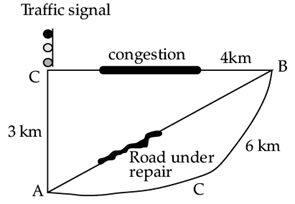
Tabu got a seat just behind the driver. He noticed that the minimum reading in the speedometer was 15 km/h. But ultimately the bus took 1 hour to reach B. He could not understand the fallacy.
Why the speedometer reading was minimum 15 km/h, bus actual time required to cover 7 km was 1 hour?
A journey:
Tabu lives at A. He was supposed to go to his uncle’s house at B. A and B is connected by a straight road 5 km long. But that day the road was under repair. So, all the buses was following a diversion via C. A to B via C is 7 km. Moreover this route is congested. There is a traffic signal at C also.
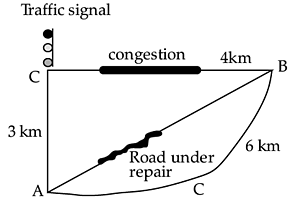
Tabu got a seat just behind the driver. He noticed that the minimum reading in the speedometer was 15 km/h. But ultimately the bus took 1 hour to reach B. He could not understand the fallacy.
If the bus followed ACB path and reached B in 1 hour, then the average speed of the bus would have been
|
9 docs|1272 tests
|


